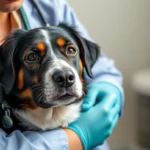
Introduction
Pet allergies are a common concern for many individuals, often leading to discomfort and difficult decisions regarding pet ownership. Understanding the specifics of pet allergies, especially the differences between reactions to cats and dogs, is crucial for those who love animals but might be susceptible to allergic reactions. The main question many ask is: can you be allergic to cats but not dogs? This article aims to provide a clear and informative answer, enriched by expert insights and research.
Understanding Pet Allergies
What Are Pet Allergies?
Pet allergies occur when the immune system overreacts to proteins found in a pet’s skin cells, urine, or saliva. These proteins, known as allergens, can trigger various symptoms in sensitive individuals. Common symptoms associated with pet allergies include:
- Sneezing
- Itching
- Nasal congestion
- Watery eyes
- Skin rashes
These reactions can range from mild to severe, significantly impacting an individual’s quality of life.
How Allergies Develop
Allergies develop when the immune system mistakenly identifies a harmless substance (allergen) as a threat. Upon first exposure, the immune system produces antibodies to combat the allergen. Subsequent exposures can lead to an immediate allergic reaction. Several factors influence the development of allergies, including:
- Genetics: Family history plays a significant role in allergy susceptibility.
- Environment: Exposure to allergens in the environment can increase the likelihood of developing allergies.
- Exposure Levels: Frequent contact with potential allergens may heighten sensitivity over time.
The Science of Allergens
What Are Allergens?
Allergens are substances that provoke an allergic response. They can be environmental, such as pollen and dust, or animal-specific, like proteins found in pet dander. Understanding these allergens is essential for effective management of allergies.
Cat Allergens vs. Dog Allergens
The proteins responsible for allergic reactions differ between cats and dogs.
-
Fel d 1: The primary allergen found in cats, present in their skin, saliva, and urine. It is notably potent and can linger in the environment for long periods.
-
Can f 1: The main allergen in dogs, found in their skin and saliva. While it can also trigger allergic reactions, it is generally considered less potent compared to Fel d 1.
The quantity and potency of these allergens can vary between different breeds and individual animals, further complicating allergy management.
Can You Be Allergic to Cats but Not Dogs?
Expert Insights from Veterinarians
Veterinary professionals often encounter pet owners who report being allergic to one type of animal but not the other. According to Dr. Emily Thompson, a veterinary allergist, “It is entirely possible for someone to be allergic to cats but not dogs. The allergens are different, and individual sensitivities can vary widely.” This variability means that while one person may react to cat allergens, another may not experience any issues with dogs.
Case Studies and Anecdotal Evidence
Numerous case studies support the notion that individuals can be allergic to cats but not dogs. For example, a study published in the Journal of Allergy and Clinical Immunology reported that among individuals with pet allergies, approximately 30% were specifically allergic to cats while having no reaction to dogs.
Anecdotal evidence from pet owners frequently highlights the same trend; many report that they can comfortably live with dogs without experiencing any allergic symptoms, while being severely affected by cat dander.
Cross-Reactivity and Sensitivity
Cross-reactivity occurs when the immune system responds to proteins from different species that are structurally similar. In the case of cat and dog allergens, this means that while many individuals may react specifically to Fel d 1 or Can f 1, some might experience sensitivity to both due to similar protein structures. However, this is not the norm, and many people exhibit a clear distinction in their reactions.
Diagnosis and Testing for Allergies
Common Methods for Allergy Testing
If you suspect you or a family member may be allergic to pets, it’s essential to seek a professional diagnosis. Common methods for allergy testing include:
- Skin Tests: Involves exposing the skin to small amounts of allergens and observing for reactions.
- Blood Tests: Measures the immune system’s response to specific allergens by checking for immunoglobulin E (IgE) antibodies.
Both methods have their advantages, and a veterinarian can help determine the most appropriate testing based on individual circumstances.
Importance of Professional Diagnosis
It’s crucial to consult with a veterinarian or an allergist for a proper diagnosis rather than self-diagnosing. Self-diagnosis can lead to incorrect assumptions and ineffective management strategies, potentially worsening symptoms or leading to unnecessary pet rehoming.
Managing Pet Allergies
Strategies for Allergy Management
Managing pet allergies involves a combination of environmental controls and medical interventions. Here are some effective strategies:
- Environmental Controls:
- Use air purifiers equipped with HEPA filters to reduce airborne allergens.
- Regularly clean and vacuum living spaces to eliminate dander and other allergens.
-
Designate pet-free zones in the home, particularly in bedrooms.
-
Medication Options:
- Antihistamines can help alleviate symptoms such as sneezing and itching.
- Corticosteroids may be prescribed for more severe reactions or inflammation.
Lifestyle Adjustments
For those who love pets but also suffer from allergies, lifestyle adjustments can make a significant difference:
- Regular Grooming: Frequent grooming of pets can help reduce the amount of dander in the home.
- Bathing Pets: Regular baths can help minimize allergen buildup on pet fur.
- Choosing the Right Pet: Consider adopting a dog breed known to produce fewer allergens if allergies are a concern.
Alternatives to Traditional Pet Ownership
If traditional pet ownership proves too challenging due to allergies, there are alternatives:
-
Hypoallergenic Breeds: Certain dog breeds are considered hypoallergenic, producing fewer allergens than others. Breeds such as Poodles and Bichon Frises are often recommended for allergy sufferers.
-
Non-Pet Alternatives: For those seeking companionship without the allergens, consider options such as small mammals, reptiles, or even fish, which do not produce the same types of allergens as cats or dogs.
Frequently Asked Questions (FAQs)
Can allergies develop over time?
Yes, allergies can develop at any age. It’s possible for someone to have no allergy symptoms in childhood but develop them later in life due to changes in environment or genetics.
Are there hypoallergenic cats and dogs?
While no pet is entirely hypoallergenic, some breeds are known to produce fewer allergens. For dogs, breeds like Poodles and Schnauzers are often recommended, while for cats, breeds such as the Siberian and Balinese may be better tolerated.
What should I do if I suspect I’m allergic to my pet?
Consult a veterinarian or allergist for testing and guidance. They can help confirm whether your symptoms are related to your pet and recommend appropriate management strategies.
How can I tell if my allergy is from my pet or something else?
Tracking symptoms and their correlation with pet exposure can help. Professional allergy testing is the most reliable way to determine specific allergens.
Conclusion
Understanding the nuances of pet allergies is vital for making informed decisions about pet ownership. The possibility of being allergic to cats but not dogs is well-supported by both expert insights and real-life experiences. By taking proactive steps towards diagnosis and management, individuals can enjoy a fulfilling life with pets while minimizing allergic reactions. For personalized advice and solutions, consulting with a veterinarian is always recommended.









